Indications of fraud in the June 12 Iranian presidential election, together with large-scale street demonstrations, have led to claims that Mahmoud Ahmadinejad did not actually win the election, and that the majority of Iranians perceive their government as illegitimate and favor regime change.
An analysis of multiple polls of the Iranian public from three different sources finds little evidence to support such conclusions.
The analysis conducted by the Program on International Policy Attitudes at the University of Maryland (PIPA), was based on:
- a series of 10 recently-released polls conducted by the University of Tehran; eight conducted in the month before the June 12 election and two conducted in the month after the election, based on telephone interviews conducted within Iran
- a poll by GlobeScan conducted shortly after the election, based on telephone interviews conducted within Iran
- a poll by WorldPublicOpinion.org (managed by PIPA) conducted August 27–September 10, based on telephone interviews made by calling into Iran
  
|
The study sought to address the widely-discussed hypotheses that Ahmadinejad did not win the June 12 election and that the Iranian people perceive their government as illegitimate. It also sought to explore the assumption that the opposition represents a movement favoring a substantially different posture toward the United States. The analysis of the data found little evidence to support any of these hypotheses.
Steven Kull, director of PIPA, said, “Our analysis suggests that it would not be prudent to base US policy on the assumption that the Iranian public is in a pre-revolutionary state of mind.”
On the question of whether Ahmadinejad won the June 12 election, in the week before the election and after the election, in all polls a majority said they planned to or did vote for Ahmadinejad. These numbers ranged from 52 to 57% immediately before the election and 55 to 66% after the election.
Steven Kull comments, “These findings do not prove that there were no irregularities in the election process. But they do not support the belief that a majority rejected Ahmadinejad.”
The analysis did reveal factors that could have contributed to the impression that Ahmadinejad did not win. University of Tehran polls show that in the first few weeks of the campaign his support dropped precipitously and he did not enjoy majority support in the city of Tehran. But in the week before the election, his support recovered outside the capital.
Going into the election 57% said they expected Ahmadinejad to win. Thus it is not surprising that, in several post-election polls, more than seven in ten said they saw Ahmadinejad as the legitimate president. About eight in ten said the election was free and fair.
The polls did reveal some reservations about the government. Less than a majority expressed full confidence in the Guardian Council (42%) and the Ministry of the Interior (38%). While over eight in ten said they were satisfied with the current system of government, in June less than a majority (49%) said they were very satisfied and this number dropped to 41% in July.
However none of the polls found indications of support for regime change. Large majorities, including majorities of Mousavi supporters, endorse the Islamist character of the regime such as having a body of Islamic scholars with the power to veto laws they see as contrary to sharia.
To address the possibility that the data collected within Iran may have been fabricated, PIPA compared the patterns of responses, including within subgroups, in data collected inside Iran to those collected by calling into Iran from the outside. Steven Kull comments, “The patterns of responses at many levels are so similar, whether the data was collected inside Iran or by calling into Iran, that it is hard to conclude that these data were fabricated.”
Another concern is that Iranian respondents were not answering candidly out of fear of some type of reprisal for making statements in support of the opposition or critical of the regime, particularly in the post-election environment. As noted above, on some questions majorities expressed views that were less than fully laudatory of the government.
Still there was the fact that after the election, the numbers expressing support for Mousavi diminished suggests that some self-censoring may have been occurring. Thus PIPA put special emphasis on analyzing the responses of those who felt bold enough to say that they voted for the opposition on the assumption that they would be frank on other issues as well. While Mousavi supporters are less affirmative of the legitimacy of the regime than the public as a whole, still a majority says that they believe that Ahmadinejad is the legitimate president and affirm the Islamist nature of the regime.
Some analysts have suggested that if the opposition were to gain power this would lead to fundamental changes in the Iranian posture toward the US. Focusing on those respondents who said they voted for Mousavi, as an approximation of the opposition, PIPA found that a majority were ready to negotiate with the US on a number of issues, while the Iranian public as a whole was more divided. However, Mousavi supporters, like the general public, were quite negative in their views of the US government and were strongly committed to Iran’s nuclear program.
A majority of Mousavi supporters did favor diplomatic relations with the US, and were ready to make a deal whereby Iran would preclude developing nuclear weapons through intrusive international inspections in exchange for the removal of sanctions. However, this was equally true of the majority of all Iranians.
Full Report (PDF)
Questionnaire with Findings, Methodology for All Three Surveys (PDF)WPO Dataset for Download (SPSS Format)
GlobeScan Dataset for Download (SPSS Format)
WorldPublicOpinion.org was initiated and managed by the Program on International Policy Attitudes at the University of Maryland. This article was first published by WorldPublicOpinion.org on 3 February 2010; it is reproduced here for non-profit educational purposes.
|
| Print
